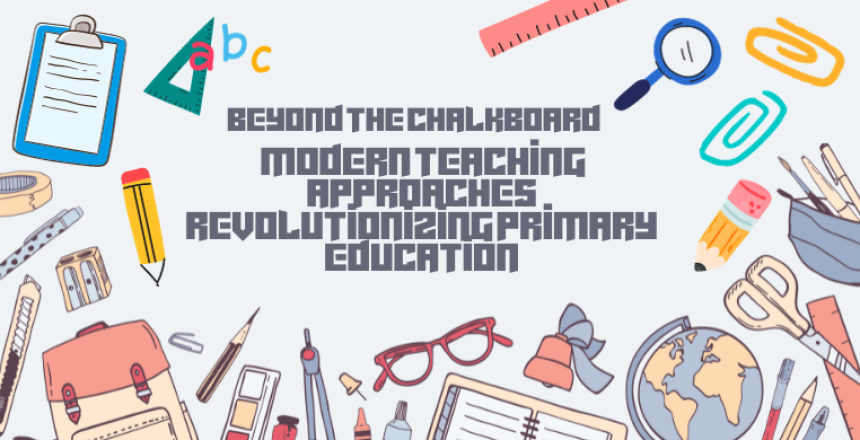Introduction
The landscape of primary education has undergone a significant transformation over the years, moving beyond traditional teaching methods centered around the blackboard. In today’s dynamic world, the role of primary teachers has evolved to incorporate innovative approaches, making the classroom a hub of interactive learning experiences. This blog delves into the modern teaching approaches revolutionizing primary education, emphasizing the importance of dynamic teacher-student relationships, interactive learning environments, and the use of technology. Let’s explore how these evolving techniques are shaping the future of education.
1. The Evolution of Primary Teaching: From Chalkboard to Collaboration
Traditionally, the image of a primary teacher at the blackboard, delivering lectures to passive students, was pervasive. However, contemporary primary teaching has embraced dynamic and engaging methods. Modern educators recognize the importance of fostering collaborative relationships with students. Instead of being mere disseminators of information, teachers are now facilitators of learning, encouraging active participation, critical thinking, and creativity among their students.
2. Interactive Learning Environments: Encouraging Curiosity and Exploration
Primary education is no longer confined to the four walls of a classroom. Interactive learning environments stimulate curiosity and exploration, providing students with hands-on experiences that enhance their understanding of various subjects. Teachers design activities and projects that encourage students to work together, fostering teamwork and problem-solving skills. These environments promote a love for learning by making education a captivating and immersive experience.
3. Technology in the Classroom: Empowering Teaching and Learning
Technology has become an indispensable tool in modern primary education. Interactive whiteboards, tablets, educational apps, and online resources offer a vast array of teaching possibilities. Teachers use multimedia presentations to make lessons visually appealing and interactive, catering to diverse learning styles. Moreover, technology allows for personalized learning experiences, enabling students to progress at their own pace, ensuring that no child is left behind. Integrating technology into the curriculum not only enhances student engagement but also prepares them for the digital challenges of the future.
4. Flipped Classroom Model: Reinventing Homework and Classwork
The flipped classroom model reverses the traditional approach to homework and classwork. Instead of introducing new concepts during class time, teachers provide instructional content, such as videos or readings, as homework. Classroom time is then dedicated to discussions, activities, and problem-solving, where teachers guide students through the application of knowledge. This approach promotes active learning, encouraging students to explore topics independently, and seek clarification from teachers when needed.
5. Project-Based Learning: Fostering Creativity and Critical Thinking
Project-based learning immerses students in real-world, meaningful projects that require collaboration, research, and problem-solving. Teachers design projects that align with the curriculum, allowing students to explore topics in depth. These projects often culminate in presentations, exhibitions, or performances, showcasing students’ creativity and understanding. Project-based learning not only enhances subject knowledge but also nurtures important life skills such as communication, time management, and adaptability.
6. Student-Centered Teaching: Nurturing Autonomy and Responsibility
In student-centered teaching, the focus shifts from the teacher as the sole source of knowledge to the students as active participants in their learning journey. Teachers guide and support students as they explore topics, ask questions, and find solutions. This approach encourages students to take ownership of their learning, fostering autonomy and responsibility. Student-centered teaching promotes a growth mindset, where mistakes are viewed as opportunities to learn and grow, creating resilient and self-motivated learners.
7. Assessments: Moving Beyond Tests to Measure Understanding
Modern teaching approaches emphasize the importance of varied and authentic assessments. While traditional tests have their place, educators utilize a wide range of assessment methods to gauge students’ understanding and skills. These methods include presentations, projects, group discussions, and practical demonstrations. By diversifying assessments, teachers gain a comprehensive understanding of students’ abilities, allowing them to provide targeted support and encouragement.
Conclusion: Shaping the Future of Education
The evolution of primary teaching from the chalkboard-centric model to dynamic, student-centered approaches marks a paradigm shift in education. As primary educators embrace interactive learning environments, technology integration, and innovative teaching methods, they empower students to become lifelong learners equipped with essential skills for the future. The nurturing and supportive relationship between teachers and students lies at the heart of this transformation, creating an environment where curiosity, creativity, and critical thinking thrive. As we continue to explore and refine these modern teaching approaches, we are shaping a future where every child’s potential is unlocked, and education becomes a transformative and empowering journey. Through these innovative methods, primary education not only imparts knowledge but also nurtures the leaders, innovators, and problem solvers of tomorrow, paving the way for a brighter and more enlightened society.
